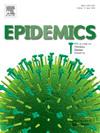Does spatial information improve forecasting of influenza-like illness?
IF 2.4
3区 医学
Q2 INFECTIOUS DISEASES
引用次数: 0
Abstract
Seasonal influenza forecasting is critical for public health and individual decision making. We investigate whether the inclusion of data about influenza activity in neighboring states can improve point predictions and distribution forecasting of influenza-like illness (ILI) in each US state using statistical regression models. Using CDC FluView ILI data from 2010–2019, we forecast weekly ILI in each US state with quantile, linear, and Poisson autoregressive models fit using different combinations of ILI data from the target state, neighboring states, and the US population-weighted average. Scoring with root mean squared error and weighted interval score indicated that the covariate sets including neighbors and/or the US weighted average ILI showed slightly higher accuracy than models fit only using lagged ILI in the target state, on average. Additionally, the improvement in performance when including neighbors was similar to the improvement when including the US average instead, suggesting the proximity of the neighboring states is not the driver of the slight increase in accuracy. There is also clear within-season and between-season variability in the effect of spatial information on prediction accuracy.

空间信息能改善流感样疾病的预测吗?
季节性流感预测对公共卫生和个人决策至关重要。我们使用统计回归模型研究是否将邻近州流感活动数据纳入可以改善美国每个州流感样疾病(ILI)的点预测和分布预测。利用CDC FluView 2010-2019年的ILI数据,我们使用分位数、线性和泊松自回归模型对美国每个州的每周ILI进行预测,这些模型使用来自目标州、邻近州和美国人口加权平均值的ILI数据的不同组合进行拟合。用均方根误差和加权区间得分进行评分表明,包含邻居和/或美国加权平均ILI的协变量集平均比仅使用滞后ILI拟合的模型在目标状态下的准确率略高。此外,包括邻居时的性能改进与包括美国平均水平时的改进相似,这表明邻近州的接近程度并不是准确性略有提高的驱动因素。空间信息对预测精度的影响也存在明显的季节内和季节间变异性。
本文章由计算机程序翻译,如有差异,请以英文原文为准。
求助全文
约1分钟内获得全文
求助全文
来源期刊

Epidemics
INFECTIOUS DISEASES-
CiteScore
6.00
自引率
7.90%
发文量
92
审稿时长
140 days
期刊介绍:
Epidemics publishes papers on infectious disease dynamics in the broadest sense. Its scope covers both within-host dynamics of infectious agents and dynamics at the population level, particularly the interaction between the two. Areas of emphasis include: spread, transmission, persistence, implications and population dynamics of infectious diseases; population and public health as well as policy aspects of control and prevention; dynamics at the individual level; interaction with the environment, ecology and evolution of infectious diseases, as well as population genetics of infectious agents.
 求助内容:
求助内容: 应助结果提醒方式:
应助结果提醒方式:


